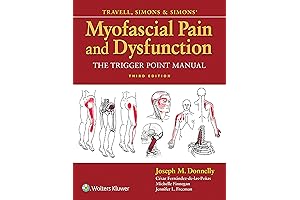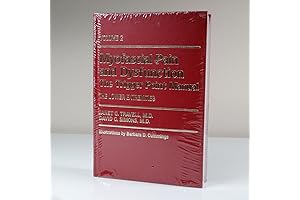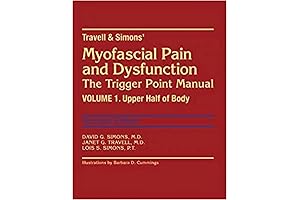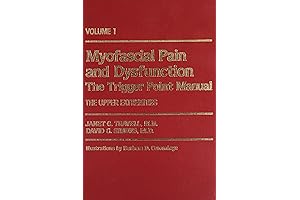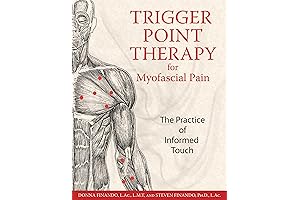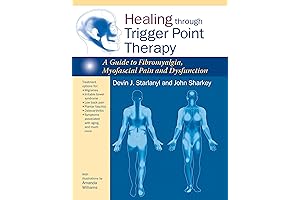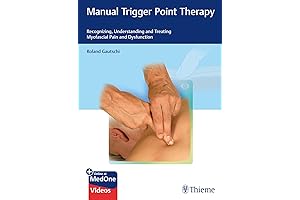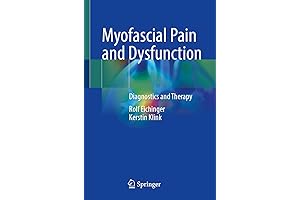· myofascial pain · 14 min read
The Definitive Guide to Myofascial Pain and Dysfunction: Remedies and Treatments
Explore the causes, diagnosis, and effective treatments for myofascial pain and dysfunction. Discover the latest advancements in trigger point therapy and find relief from chronic pain.
Myofascial pain and dysfunction (MFD) is a common condition that causes pain, stiffness, and tenderness in the muscles and connective tissues. It can be caused by a variety of factors, including injuries, poor posture, and stress. MFD can be difficult to diagnose, but there are a number of effective treatments available.
Overview

PROS
- Comprehensive and detailed guide to myofascial pain and dysfunction.
- Evidence-based treatment techniques and protocols.
- Includes over 1,200 illustrations and photographs.
- Authored by leading experts in the field.
CONS
- Can be overwhelming for beginners.
- Expensive.
- Some sections require medical background.
Travell, Simons & Simons' Myofascial Pain and Dysfunction is the definitive guide to understanding and treating myofascial pain, a common condition that causes muscle pain, stiffness, and tenderness. The third edition of this classic text has been extensively updated and revised to reflect the latest research and advances in the field.
The book is divided into three parts. The first part provides an overview of myofascial pain, including its causes, symptoms, and diagnosis. The second part describes the various trigger points that can cause myofascial pain, and provides detailed instructions on how to locate and treat them. The third part discusses the various treatment options for myofascial pain, including medication, physical therapy, and massage.
Travell, Simons & Simons' Myofascial Pain and Dysfunction is an essential resource for anyone who treats myofascial pain. It is a comprehensive, evidence-based guide that will help you to understand and treat this condition.

PROS
- Comprehensive guide to myofascial pain and dysfunction in the lower extremities
- Expert insights and practical techniques for pain management
CONS
- Somewhat technical language may require prior knowledge
- Limited focus on non-trigger point approaches
In 'Myofascial Pain and Dysfunction: The Trigger Point Manual; Vol. 2., The Lower Extremities', renowned experts Janet G. Travell and David G. Simons deliver an authoritative guide to identifying and treating myofascial pain. Focusing on the lower extremities, this comprehensive manual empowers practitioners with valuable knowledge and techniques.
This volume meticulously describes the anatomy and physiology of the lower extremities, including the location and characteristics of trigger points. Travell and Simons provide clear and concise instructions for palpating and deactivating these trigger points, enabling practitioners to effectively alleviate myofascial pain at its source. The manual also includes a range of self-treatment techniques that empower patients to manage their pain independently.
While the content is geared towards healthcare professionals, individuals experiencing myofascial pain may also find valuable insights. However, the technical nature of the language may require some prior knowledge or guidance from a healthcare practitioner. Additionally, the primary focus on trigger point therapy may overlook other aspects of myofascial pain management.

PROS
- Provides comprehensive techniques for releasing myofascial pain and dysfunction in the upper body
- Includes detailed illustrations and step-by-step instructions for effective trigger point release
CONS
- Some readers may find the language too technical
- May require professional guidance for optimal results
Experience freedom from myofascial pain and dysfunction with this remarkable guide. Delving into the intricacies of trigger points in the upper body, this manual empowers you with proven techniques to alleviate pain and restore optimal function. Through meticulously crafted illustrations and easy-to-follow instructions, you'll master the art of releasing trigger points, unlocking lasting relief from chronic pain.
Whether you're a healthcare professional seeking to enhance your treatment strategies or an individual seeking self-empowerment in managing pain, this guide is an invaluable resource. Its comprehensive approach provides a holistic understanding of myofascial pain and dysfunction, offering a transformative pathway towards pain-free living. Embrace the power of trigger point therapy and reclaim control over your well-being with this exceptional guide.

PROS
- Comprehensive guide to myofascial pain and dysfunction in the upper extremities
- Detailed descriptions of trigger points, their referred pain patterns, and treatment techniques
- Clear and concise instructions for self-treatment and professional interventions
- Supported by extensive research and clinical experience
- Helps improve mobility, reduce pain, and enhance overall well-being
CONS
- May require additional professional guidance for complex cases
- Some techniques may cause temporary discomfort
Myofascial Pain and Dysfunction, Vol. 1: The Trigger Point Manual, The Upper Extremities is an invaluable resource for anyone experiencing pain or dysfunction in the upper body due to myofascial trigger points. This comprehensive manual provides a thorough understanding of the causes, symptoms, and treatment options for this common condition. Its detailed descriptions of trigger points and their referred pain patterns empower readers to identify and address the root causes of their pain.
The manual is written by Janet Travell, MD, and David G. Simons, MD, leading experts in the field of myofascial pain. Their extensive research and clinical experience shine through in the clear and concise instructions provided for both self-treatment and professional interventions. By following the techniques outlined in this book, individuals can effectively reduce pain, improve mobility, and restore overall well-being.

PROS
- Expert guidance on identifying and treating myofascial trigger points
- Comprehensive exploration of the anatomy and physiology of myofascial pain
- Evidence-based techniques for effective pain management
CONS
- Can be complex for beginners, requiring careful study and practice
- May not be suitable for all types of myofascial pain
In 'Trigger Point Therapy for Myofascial Pain: The Practice of Informed Touch', renowned pain expert Dr. David G. Simons delves into the enigmatic world of myofascial pain, providing a comprehensive guide to its diagnosis and treatment. With meticulous precision, Dr. Simons illuminates the intricate anatomy of the muscular system, shedding light on the elusive trigger points that can wreak havoc on our well-being. Drawing upon extensive clinical experience, he unveils the profound impact of informed touch, empowering readers to address myofascial pain with precision and effectiveness.
Structured in an accessible yet comprehensive manner, this seminal work empowers practitioners and individuals alike to unravel the complexities of myofascial pain. Through a blend of scientific rigor and practical insights, Dr. Simons empowers readers to master the art of trigger point therapy, transforming them into pain management advocates. By integrating a holistic approach that encompasses anatomy, physiology, and clinical practice, 'Trigger Point Therapy for Myofascial Pain' stands as an indispensable resource for alleviating myofascial suffering and restoring optimal well-being.

PROS
- Effectively targets myofascial trigger points to alleviate pain and restore mobility
- Promotes deep tissue release, reducing muscle tension and promoting relaxation
- Ergonomic design allows for precise application of pressure to specific muscle groups
- Versatile tool for self-massage or professional treatments, empowering users to proactively manage pain
CONS
- May cause temporary discomfort during use, especially on sensitive areas
- Requires consistent use to achieve optimal results, which may not be suitable for all individuals
Experience the transformative power of targeted myofascial release with the Trapezius Trigger Point Massager. Designed to combat the discomfort associated with myofascial pain and dysfunction, this innovative tool empowers you to tackle muscle tension and headaches head-on. Its ergonomic form seamlessly adapts to your body's contours, enabling precise application of pressure to specific trigger points. Feel the tension melt away as deep tissue release rejuvenates your muscles, promoting relaxation and restoring range of motion. Whether you're a seasoned massage therapist or seeking self-care solutions, the Trapezius Trigger Point Massager is an invaluable companion on your journey towards pain relief and enhanced well-being.
Unleash the benefits of myofascial release with the Trapezius Trigger Point Massager. Its compact and portable design makes it an ideal travel companion, allowing you to alleviate tension wherever you go. Crafted from durable materials, this massager withstands regular use, ensuring lasting relief. Experience the transformative power of targeted muscle therapy and elevate your overall well-being with the Trapezius Trigger Point Massager.

PROS
- Comprehensive guide to self-myofascial release techniques
- Detailed illustrations and step-by-step instructions for accurate trigger point location and treatment
- Effective strategies for alleviating myofascial pain and dysfunction
- Empowering individuals to manage their pain independently
- Expert guidance to restore optimal muscle function and reduce chronic pain
CONS
- May require consistency and dedication for effective results
- Some techniques may cause temporary discomfort
Discover the power of self-treatment with 'The Trigger Point Therapy Workbook'! This comprehensive guide unlocks the secrets of myofascial release, empowering you to alleviate pain and restore muscle function. Immerse yourself in detailed illustrations and precise instructions that guide you in pinpointing and treating trigger points, the underlying culprits of myofascial pain and dysfunction.
Experience the transformative effects of expert guidance as you master self-myofascial release techniques. Reclaim control over your pain management journey by implementing these effective strategies, designed to reduce chronic pain and enhance overall well-being. Whether you're a seasoned practitioner or an individual seeking relief from myofascial discomfort, this workbook offers a path to pain freedom.

PROS
- Provides evidence-based treatment strategies for managing myofascial pain and dysfunction.
- Empowers individuals with self-care techniques to alleviate pain and improve mobility.
- Features comprehensive explanations of trigger point therapy, its benefits, and application methods.
- Offers insights into the underlying causes and mechanisms of myofascial pain, promoting a holistic understanding.
- Includes practical exercises and stretches tailored to specific pain conditions, facilitating personalized pain management.
CONS
- May require additional professional guidance for complex pain conditions.
- Self-treatment may not be suitable for all individuals, particularly those with severe or chronic pain.
Discover a comprehensive guide to managing myofascial pain and dysfunction with "Healing through Trigger Point Therapy." This invaluable resource unravels the complexities of trigger point therapy, empowering you with self-care strategies to alleviate pain and regain mobility. Through evidence-based treatment approaches and practical exercises, this guide equips you with the knowledge and tools to reclaim your well-being. Embrace a holistic understanding of myofascial pain and unlock the path to healing.
Tailored to individuals living with fibromyalgia, myofascial pain, and dysfunction, this guide provides personalized pain management solutions. Its in-depth explanations and practical applications empower you to address your pain effectively. Whether you're a healthcare professional or an individual seeking relief, "Healing through Trigger Point Therapy" serves as an indispensable tool for understanding, managing, and overcoming myofascial pain and dysfunction.

PROS
- Provides an in-depth exploration of myofascial pain and dysfunction, empowering healthcare professionals with a comprehensive understanding.
- Brilliantly combines scientific principles and practical techniques, enabling readers to effectively identify and treat trigger points.
CONS
- Some readers may find the comprehensive nature of the book to be overwhelming initially.
- The advanced techniques discussed may require additional training or supervision for safe and effective application.
Step into the world of 'Manual Trigger Point Therapy' and embark on a transformative journey towards resolving myofascial pain. This comprehensive guide stands as an invaluable resource for physical therapists, massage therapists, and healthcare professionals alike, offering an in-depth exploration of the intricate relationship between pain and dysfunction. Through the seamless integration of scientific principles and practical techniques, you'll gain a comprehensive understanding of myofascial pain and its impact on movement limitations, empowering you to effectively alleviate pain and restore optimal function.
The authors, recognized experts in the field, have meticulously crafted this book to provide a systematic approach to recognizing, understanding, and treating myofascial pain. With a wealth of clinical pearls and clear, step-by-step instructions, you'll master the art of trigger point therapy, unlocking the path to pain-free movement for your patients or clients. Prepare to elevate your practice and empower individuals to reclaim their pain-free, active lifestyles with 'Manual Trigger Point Therapy: Essential Guide for Resolving Painful Movement Limitations.' As you delve into its pages, you'll uncover an indispensable tool that will transform your approach to myofascial pain and dysfunction management, propelling your practice to new heights of success.

PROS
- Enlightening understanding of myofascial pain's mechanisms and manifestations
- Valuable guidance on accurate diagnosis and effective treatment
CONS
- Limited coverage of advanced treatment modalities
- Some sections lack in-depth exploration of specific conditions
This comprehensive guide to myofascial pain and dysfunction is a valuable resource for clinicians seeking to enhance their understanding and treatment of this prevalent condition. The book provides a detailed examination of the mechanisms underlying myofascial pain, including the roles of trigger points, fascia, and the nervous system. This knowledge is crucial for accurate diagnosis and the development of effective treatment plans.
The authors have skillfully integrated theory with practical guidance, offering a wealth of assessment and treatment techniques. They emphasize the importance of a holistic approach that considers both physical and psychological factors contributing to myofascial pain. This approach aligns with current best practices and ensures a comprehensive approach to patient care.
Myofascial pain and dysfunction is a complex condition that can have a significant impact on your quality of life. However, there are a number of effective treatments available that can help to relieve your pain and improve your function. If you are suffering from MFD, it is important to see a healthcare professional to get a diagnosis and develop a treatment plan.
Frequently Asked Questions
What is myofascial pain and dysfunction?
Myofascial pain and dysfunction (MFD) is a condition that causes pain, stiffness, and tenderness in the muscles and connective tissues. It is caused by trigger points, which are small, tight knots that form in the muscles.
What are the symptoms of myofascial pain and dysfunction?
The symptoms of MFD can vary depending on the location of the trigger points. Common symptoms include pain, stiffness, tenderness, and difficulty moving the affected muscles.
What causes myofascial pain and dysfunction?
MFD can be caused by a variety of factors, including injuries, poor posture, and stress. It can also be caused by other medical conditions, such as fibromyalgia and arthritis.
How is myofascial pain and dysfunction diagnosed?
MFD is diagnosed by a physical examination. Your doctor will feel for trigger points in your muscles and assess your range of motion.
How is myofascial pain and dysfunction treated?
There are a number of effective treatments for MFD, including trigger point therapy, massage therapy, and stretching. Your doctor may also recommend medications to help relieve your pain.
